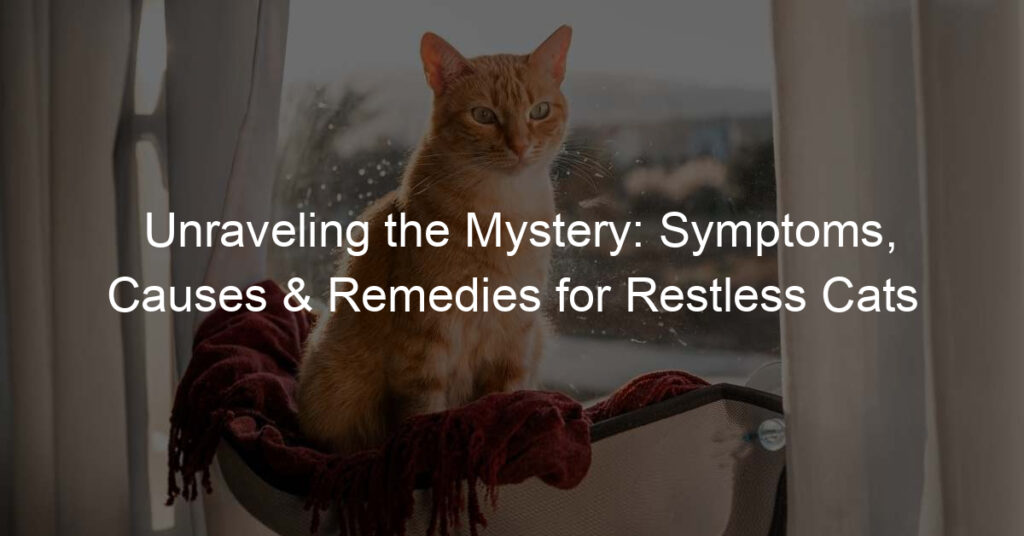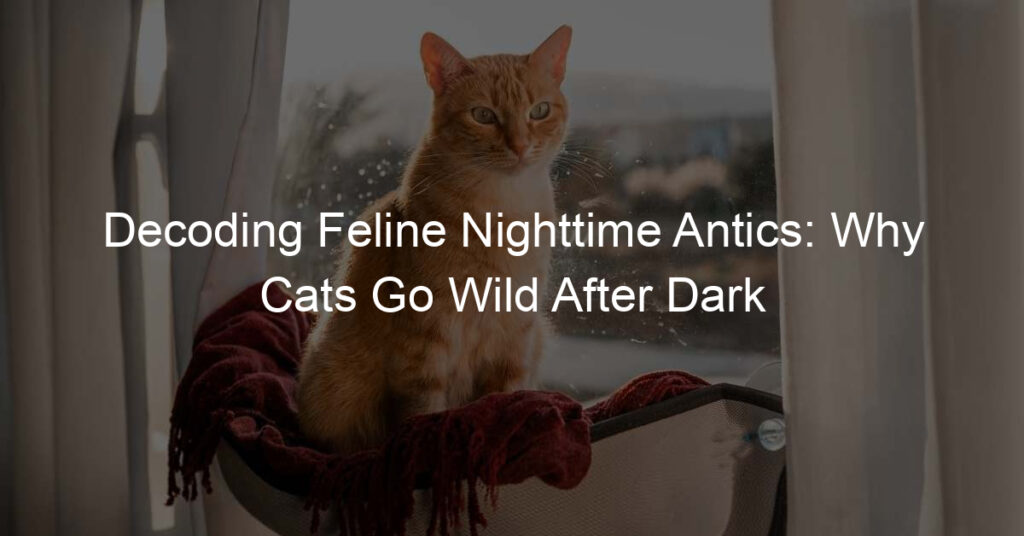
Introduction: Decoding Feline Mysteries
Ever wondered why your feline friend behaves differently at night? You’re not alone. Many cat owners are puzzled by their pet’s nighttime antics. This article aims to decode these feline mysteries and help you understand your cat’s night behavior better.
- Understanding your cat’s night behavior
- Reasons for cat’s nighttime behavior
Cats are known to be crepuscular, which means they are most active during the twilight hours of dawn and dusk. This behavior is a result of their natural hunting instincts. At night, cats often exhibit behaviors such as running around, playing with toys, or even meowing loudly. While this may seem strange to us, it’s perfectly normal for them.
There are several reasons why your cat might be more active at night. One of the main reasons is their natural instinct to hunt. In the wild, cats hunt during the night when their prey is most active. Even though domestic cats don’t need to hunt for food, they still retain this instinct.
Another reason could be that your cat is not getting enough exercise during the day. Cats need physical activity to burn off energy. If they don’t get enough exercise during the day, they might be more active at night.
Lastly, your cat might be bored. Cats are intelligent creatures and need mental stimulation. If they don’t get enough of it during the day, they might resort to nighttime activities to keep themselves entertained.
In the following sections, we will delve deeper into these behaviors and provide practical tips on how to understand and manage your cat’s night behavior. So, stay tuned and let’s embrace the mystery of cat behavior together!
Cat Behavior Explained: Nighttime Feline Antics
Have you ever wondered why your feline friend seems to become more active when the sun goes down? Cats, especially domestic ones, have a unique set of behaviors that they exhibit during the night. Let’s delve into these nighttime antics and understand why our furry friends behave the way they do after dark.
Understanding Feline Behavior: Cat Antics After Dark
Cats are naturally crepuscular, which means they are most active during the twilight hours of dawn and dusk. This is because in the wild, cats hunt during these hours as their prey is most active. While domestic cats don’t need to hunt for survival, they still retain this instinctual behavior. Let’s explore some common activities and examples of feline behavior at night.
- Common nighttime cat activities
- Examples of feline nocturnal behavior
- Zoomies: This is when your cat suddenly runs around the house at high speeds. This is a way for cats to burn off excess energy.
- Chattering: Cats often make a chattering or chirping noise at night, especially when they spot a potential prey like a bug or a bird outside the window.
- Nocturnal Play: Cats often engage in play-fighting, chasing, and pouncing at night. This is a part of their hunting instincts.
Some common activities that cats engage in at night include playing, hunting, exploring, and grooming. These activities are a part of their natural instincts and can sometimes be misinterpreted as misbehavior. It’s important to remember that these behaviors are normal and a sign of a healthy, active cat.
Here are a few examples of typical feline nocturnal behavior:
Understanding your cat’s nighttime behavior can help you better accommodate their needs and ensure they are happy and healthy. Remember, every cat is unique and may exhibit different behaviors. The key is to observe and understand their individual patterns and behaviors.
Deep Dive: Cat Behavior at Night
As the sun sets and darkness falls, our feline friends become more active. This section will delve into the intriguing world of nighttime cat behavior. We will explore a case study that provides valuable insights into what our cats do when we’re asleep.
Case Study: Nighttime Cat Activities
For this case study, we observed a domestic cat named Whiskers over a period of two weeks. Using a night vision camera, we were able to record and analyze Whiskers’ activities during the night.
- Observing a cat’s nighttime habits
- Key takeaways from the case study
Whiskers’ nighttime activities were varied. She spent a significant portion of the night exploring her environment, playing with toys, and hunting for food. She also spent time grooming herself and occasionally interacting with other household pets. Interestingly, Whiskers was most active during the early hours of the morning, just before dawn.
From our observations, we can conclude that cats are indeed more active at night. They utilize this time to explore, play, and hunt. This behavior is likely a result of their natural instincts as predators. Cats are crepuscular, which means they are most active during the twilight hours of dawn and dusk. Understanding this can help cat owners better accommodate their pets’ needs and behaviors.
In conclusion, while every cat is unique, many share common nighttime behaviors. By understanding these, we can create a more harmonious living environment for our feline friends. Remember, a happy cat is a healthy cat!
| Activity | Time Spent |
|---|---|
| Exploring | 3 hours |
| Playing | 2 hours |
| Hunting | 1 hour |
| Grooming | 30 minutes |
| Socializing | 30 minutes |
Practical Guide: Understanding Your Cat’s Night Behavior
Our feline friends are known for their mysterious antics, especially during the night. Understanding these behaviors can help you ensure your cat’s safety and maintain a peaceful household. This guide will provide practical tips and insights into your cat’s nighttime behavior.
How to Handle Nighttime Feline Antics
Dealing with your cat’s nighttime antics can be a challenge, but with the right approach, it can become a manageable task. Here are some practical tips and measures to ensure your cat’s nighttime activities are safe.
- Practical tips for dealing with cat behavior at night
- How to ensure your cat’s nighttime activities are safe
Cats are naturally nocturnal creatures, which means they are most active during the night. To handle this, try engaging your cat in play activities during the day to tire them out and encourage sleep at night. Providing a cozy sleeping area can also help your cat feel secure and promote better sleep. Remember, patience and understanding are key when dealing with your cat’s nighttime behavior.
Ensuring your cat’s safety during their nighttime escapades is paramount. Keep dangerous objects and toxic plants out of their reach. Make sure windows and doors are securely closed to prevent any unexpected escapes. If your cat enjoys exploring outdoors, consider installing a cat door that only allows them to enter and not exit during the night. Regular vet check-ups can also help monitor your cat’s health and detect any potential issues early.
In conclusion, understanding and managing your cat’s nighttime behavior requires patience, understanding, and a proactive approach. By following these tips, you can ensure your cat’s safety and enjoy a peaceful night’s sleep.
Conclusion: Embracing the Mystery of Cat Behavior
As we wrap up our exploration into the fascinating world of cat behavior, it’s important to remember that each cat is unique. Their nighttime antics, while sometimes puzzling, are a part of their natural instincts and individual personalities.
- Summary of Understanding Feline Behavior
- Final Thoughts on Cat’s Nighttime Habits
Understanding your cat’s behavior, especially their nighttime activities, requires patience and observation. Cats are primarily nocturnal creatures, with their ancestors being desert-dwelling animals. This means that their instinct is to be more active during the night.
Common nighttime behaviors include hunting, playing, and exploring. These behaviors are all part of a cat’s natural instincts. However, excessive nighttime activity or sudden changes in behavior could be a sign of a health issue and should be addressed with a veterinarian.
While cats’ nighttime habits can sometimes be disruptive to our sleep, it’s important to remember that these behaviors are a normal part of their nature. Rather than trying to change these behaviors, consider adjusting your environment to accommodate them. This could include providing toys for nighttime play or creating a safe space for them to explore.
Remember, understanding and embracing the mystery of cat behavior can lead to a more fulfilling and harmonious relationship with your feline friend.
In conclusion, the world of feline behavior is a fascinating one, filled with mystery and intrigue. By taking the time to understand and appreciate our cats’ natural instincts and behaviors, we can better cater to their needs and create a more harmonious living environment for both us and our feline companions.








